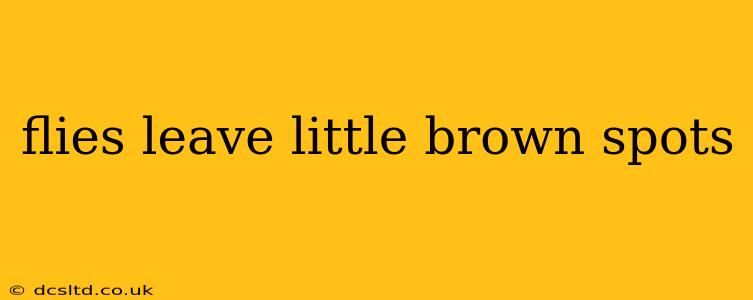Flies are a common nuisance, but their presence can sometimes leave behind more than just annoyance. The little brown spots you might find are often a cause for concern, leading to questions about their origin and potential health implications. This comprehensive guide will explore the various reasons why flies might leave these marks and how to deal with them.
What Causes the Little Brown Spots Flies Leave?
The most common culprit behind those little brown spots is feces. Flies, particularly houseflies, feed on decaying organic matter, and their digestive systems aren't designed for complete processing. Therefore, they excrete frequently, leaving behind tiny brown droplets which can dry and darken. These spots are often found near areas where flies congregate, such as garbage cans, overflowing bins, or pet waste.
Are the Brown Spots Harmful?
While generally not directly harmful in a clinical sense, these fecal spots can still pose risks. They are vectors for various bacteria and pathogens which the fly might have picked up from its feeding grounds. These bacteria can cause food contamination and potentially lead to illnesses like food poisoning if they are ingested. Furthermore, the spots themselves are unsightly and can contribute to a buildup of unsanitary conditions.
What About Other Potential Causes?
While fly feces are the primary reason, other less common possibilities include:
- Regurgitated food: Flies also regurgitate digestive fluids onto food sources to liquefy it for easier consumption. These regurgitated droplets can also leave behind small brown stains.
- Fly bodies: In cases of a large fly infestation that has undergone a natural die-off, the decaying bodies themselves might leave behind brownish stains. This is, however, considerably less common than fecal spots.
How Can I Prevent Flies From Leaving Brown Spots?
Preventing the appearance of these spots involves effectively controlling fly populations and maintaining cleanliness:
- Regular waste disposal: Empty trash cans frequently, dispose of pet waste promptly, and ensure proper sanitation of food preparation areas.
- Cleanliness is key: Regular cleaning and disinfecting of surfaces will eliminate existing spots and help prevent future ones.
- Fly control measures: Utilize fly traps, screens on windows and doors, and insecticidal sprays to reduce the fly population.
How Do I Clean Up Existing Brown Spots?
Cleaning up existing spots requires a combination of cleaning and disinfecting agents:
- Pre-cleaning: Remove as much of the dried matter as possible with a brush or vacuum cleaner.
- Disinfection: Apply a suitable disinfectant or cleaning solution to the affected area, following the manufacturer's instructions. A solution of bleach and water (typically 1 part bleach to 10 parts water) is often effective.
- Thorough rinsing: Rinse the area with clean water to remove any residual cleaning agents.
What Should I Do If I Notice a Large Infestation of Flies?
If you're dealing with a severe fly infestation, it is advisable to contact a pest control professional. They have specialized tools and knowledge to tackle larger problems effectively and safely.
This guide provides a comprehensive overview of the little brown spots left by flies. Remember, prevention and prompt cleaning are key to managing this issue and ensuring a clean and healthy environment. By addressing the underlying causes of fly infestations, you can drastically reduce the likelihood of encountering these unsightly and potentially harmful marks.
